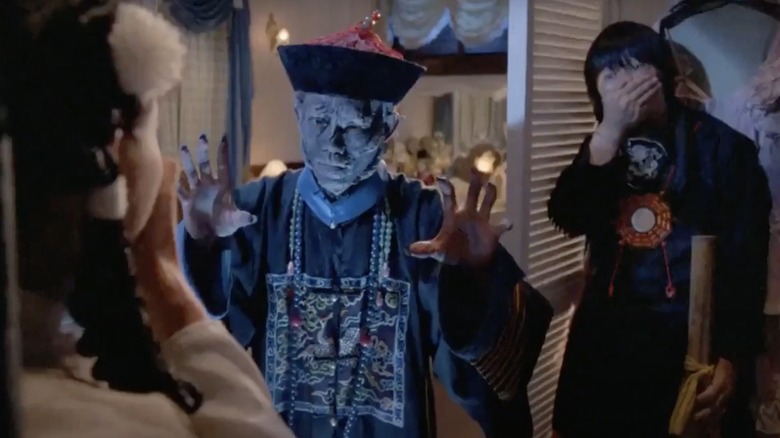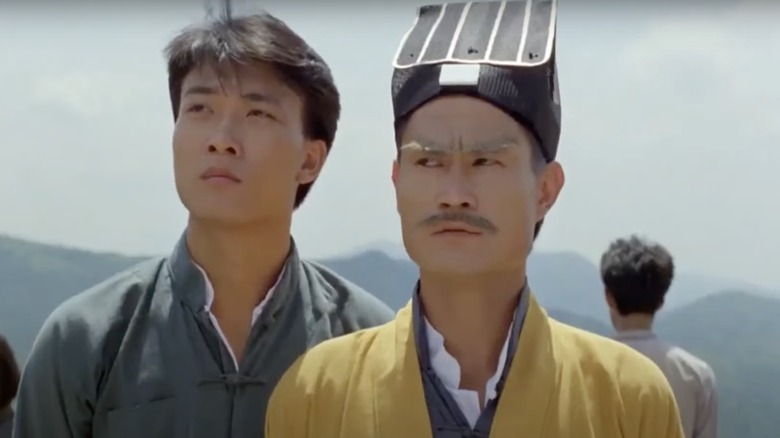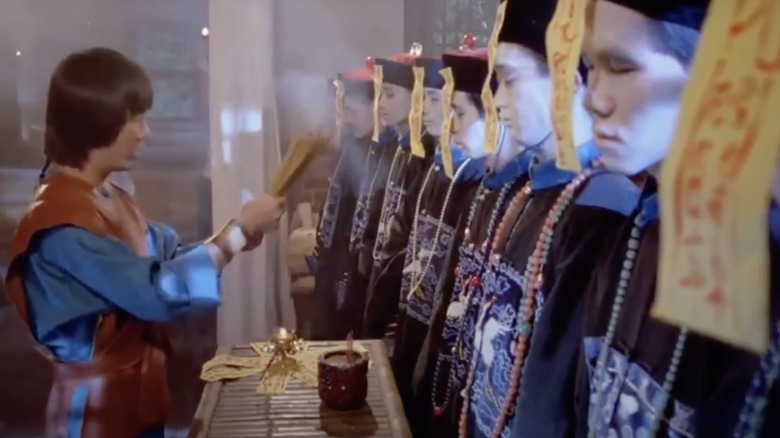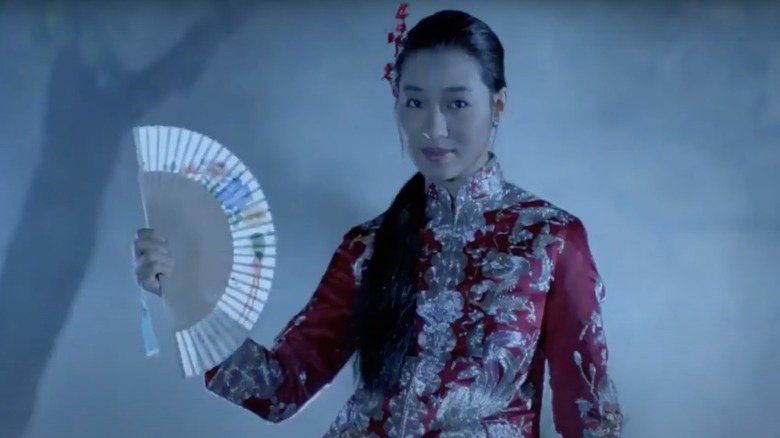Year Of The Vampire: Hold Your Breath For The Hopping Undead In Mr. Vampire
"If you meet a vampire, don't breathe." This is the sage advice that Master Kau, the Taoist priest played by Lam Ching-ying, gives to his bumbling apprentices, Man-choi (Ricky Hui) and Chau-sang (Chin Siu-ho), in the 1985 Hong Kong action comedy "Mr. Vampire."
Forget everything you know about bloodsuckers; the undead specimens in "Mr. Vampire" are breath-suckers. They have a very deliberate way of hopping with their arms stretched out in front of them, legs also stiff and straight from rigor mortis. In Chinese, these zombie-like revenants are known as the jiangshi; in Japanese, it's kyonshi, while in English, they're sometimes referred to as "Chinese hopping vampires."
Stirred up by the disinterment of a parent who was buried with bad feng shui, the jiangshi of "Mr. Vampire" are a comedic answer to the unsettled ghosts of subsequent Asian horror films like "Ringu" and "The Eye." They're the reanimated corpses of people who died "with grievances or stress," suffocating to death yet holding one last breath in their throat, which enables them to come back and prolong their existence by sinking their sharp blue nails into humans and sucking the breath out of them.
At a certain point, the tropes of Western vampire films lose their power and become cliches we've all seen done to death on celluloid. If you enjoyed the Asian zom-com flavor of "One Cut of the Dead" and are looking for something a little more off the beaten film path, "Mr. Vampire" draws from Chinese folklore to offer a fresh, hilarious take on vampires, one that jumpstarted a whole franchise and jiangshi genre, complete with four sequels and an 8-bit Nintendo video game ("Reigen Doushi," which became "Phantom Fighter" in the U.S.)
What it brought to the genre
Directed by Ricky Lau, "Mr. Vampire" found a way to uproot the undead from European folklore and Eurocentric cinema and make them work within the context of Eastern religions and Asian cultures. How do you make bloodsuckers scary and/or funny for audiences with a background in reincarnation traditions, ancestor worship, and hungry ghosts? For a Buddhist or Taoist, death and rebirth (or "undeath") would be part of a natural cycle, and for a Shintoist, a vampire might elicit sympathy as a tragic figure, trapped between worlds like the spirit of a family member who couldn't find their way back down the lantern river to heaven.
This goes back to Richard Matheson's idea of vampires not fearing crosses if they weren't Christian in life. Drawing from legends known and recognized by other names across East Asia, "Mr. Vampire" and its jiangshi enjoyed further regional popularity outside Hong Kong. Taiwan quickly followed suit with its own kid-friendly hopping vampire film "Hello Dracula," and Japan embraced both movies, making "Mr. Vampire" board games and televising "Hello Dracula" as a popular miniseries, "Yugen Doshi Kyonshizu."
In his essay, "Enter the Dracula: The Silent Screams and Cultural Crossroads of Japanese and Hong Kong Cinema" (collected in the book "Dracula, Vampires, and Other Undead Forms," edited by Caroline Joan Picart and John Edgar Browning), Wayne Stein wrote of how kids in Asia "found themselves with a new likeness to imitate by copying the hopping movements of these zany vampires," the jiangshi. I can confirm that my own spouse and her classmates were among those kids. To them, the hopping vampires of the 1980s were as much fun to emulate as the dancing zombies of Michael Jackson's "Thriller" music video.
Out-hopping The Legend of the 7 Golden Vampires
To appreciate the full significance of "Mr. Vampire" and its unprecedented local popularity as a homegrown Asian vampire movie, it's helpful to understand that it was not the first eastward voyage of the Demeter, so to speak. An early attempt at combining vampires with martial arts came in 1974 with "The Legend of the 7 Golden Vampires," which marked Peter Cushing's final outing as a vampire hunter (and now, guest lecturer in China) Van Helsing in Hammer Horror's Dracula series. The film was an international co-production between Hammer and Hong Kong's biggest production company, Shaw Brothers Studio, which was ready to capitalize on the kung fu success of the late Bruce Lee, whose posthumous hit, "Enter the Dragon," had overtaken theaters the year before.
"The Legend of the 7 Golden Vampires" proved to be a financial failure, perhaps in part because — beneath the foreign-market masquerade — its inner workings were still Western and imperialist. At the time, Hong Kong was a crown colony, and the film's opening scene sees Kah (Chan Shen), the Chinese "High Priest of the 7 Golden Vampires," kneel before the very British Dracula (John Forbes-Robertson), asking for his help back home. Dracula tells his "minion" that he doesn't roll like that; he then proceeds to spell out in no uncertain terms how he plans to appropriate Kah's culture. "I need your vile image," he says. "I will take on your mantle, your appearance."
Before the title card comes up, Dracula turns Chinese, using Kah as his host body, cackling at how "beneath the image, the immortal power of Count Dracula" still lurks. "The Legend of the 7 Golden Vampires" wore the cape of a Hong Kong vampire film, but "Mr. Vampire" tossed the cape in favor of authentic Chinese burial clothes.
How to survive a hopping vampire attack
"Mr. Vampire" imparts useful skills for what to do when you're beset by hopping vampires. Forget holy water; you need sticky rice to deal with these things. Just make sure local merchants aren't cheating you by mixing in long-grain rice with the sticky rice. That will render it less effective in preventing the "vampirification" of friends who are wounded and poisoned in the acrobatic scuffle with hopping vampires.
One surefire method of stopping a hopping vampire is to pin a Taoist talisman to its forehead. They can even be controlled and sicced on other vampires this way. Be careful not to sneeze, as this could blow the talisman off, and then you'll be s*** out of luck, as the French say.
If you yourself begin turning into a stiff-legged hopping vampire, keep active! Dance it out the way you would if you suspected you had restless leg syndrome but had never been officially diagnosed.
Mirrors, as we see in "Mr. Vampire," do repel the jiangshi, more forcefully than their Western counterparts even, so you've got that going for you, at least, if you've been weaned on the rules of Western vampire films. It is possible to plug up the nostrils of hopping vampires so they lose the scent of your breathing.
A separate peril of places in the countryside overrun by hopping vampires is the possibility of ghosts with the face of "Pauline" Wong Siu-fung enchanting you and leaving you with "love bites." As vampire attacks mount, the last resort is to try warding them off with raw poultry, saying, "Big brother, eat the chicken!" Good luck, and remember the most important rule of vampire hunting: just have fun with it.



